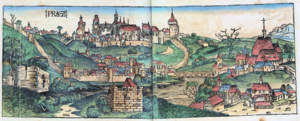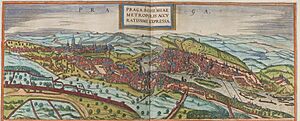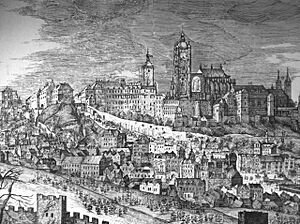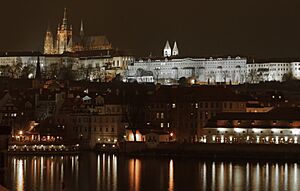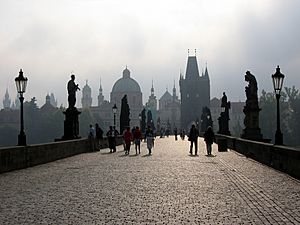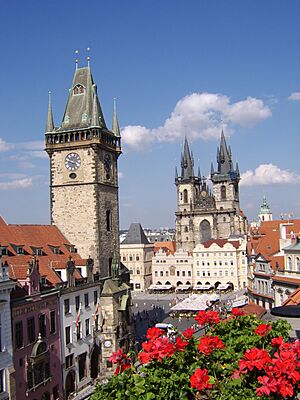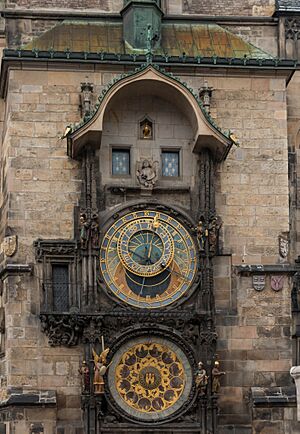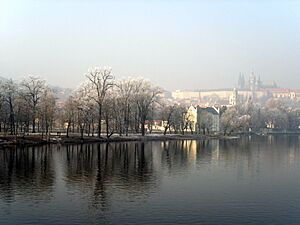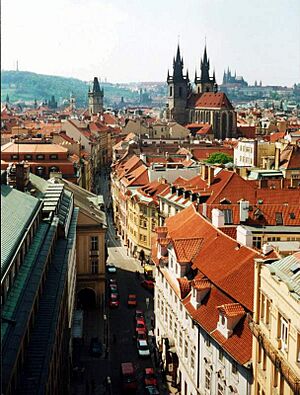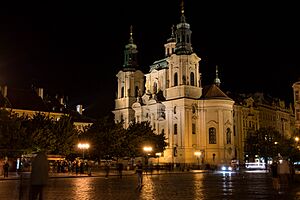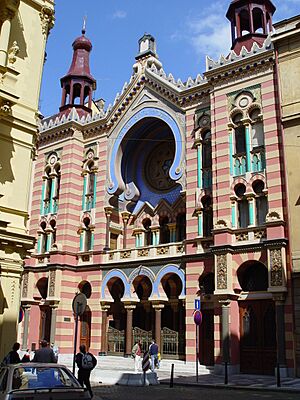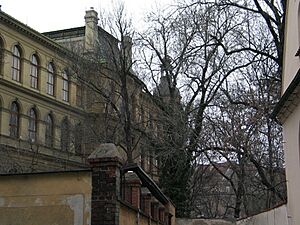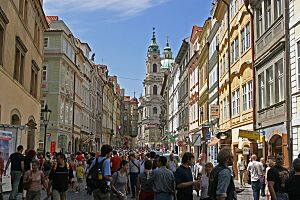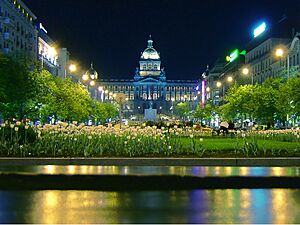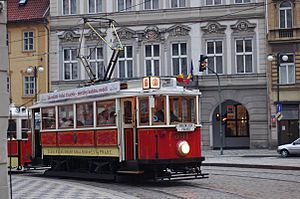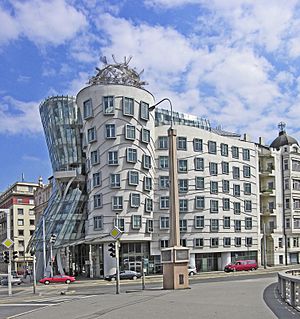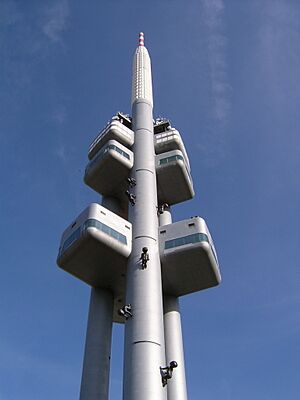History of Prague facts for kids
![]() Duchy of Bohemia c. 870–1198
Duchy of Bohemia c. 870–1198
![]() Kingdom of Bohemia 1198–1918
Kingdom of Bohemia 1198–1918
![]() Czechoslovakia 1918-1939
Czechoslovakia 1918-1939
![]() Bohemia and Moravia 1939–1945
Bohemia and Moravia 1939–1945
![]() Czechoslovakia 1945-1992
Czechoslovakia 1945-1992
![]() Czech Republic 1993-present
Czech Republic 1993-present
The history of Prague spans over a thousand years. During this time, the city grew from a small settlement around Vyšehrad Castle to become the capital of a modern European country, the Czech Republic.
Contents
Ancient Prague: The First Settlers
The area where Prague stands today has been home to people since the Stone Age. Thousands of years ago, important trade routes, connecting southern and northern Europe, passed through this region, following the Vltava river.
Around 500 BC, the Celtic tribe called the Boii lived here. They gave their name to the region, Bohemia, and the Vltava River. Later, a Germanic tribe called the Marcomanni arrived. Over time, different groups of people moved through and settled in this land.
A Prophecy of Prague's Future
According to an old legend, Princess Libuše, who ruled the Czech tribe, had a special gift for seeing the future. From her castle, she made a famous prophecy about Prague. She said: "I see a great city, whose glory will touch the stars! I see a place in the middle of a forest where a steep cliff rises above the Vltava River. There is a man, who is chiselling the threshold (prah) for the house. A castle named Prague (Praha) will be built there. Just as princes and dukes stoop in front of a threshold, they will bow to the castle and to the city around it. It will be honored, favored with great fame, and praised by the entire world." This legend explains how Prague got its name.
Medieval Prague: Castles, Kings, and Changes
From about 900 AD to 1306, the Czech Přemyslid dynasty ruled most of Bohemia. The first known Czech ruler was Prince Bořivoj Přemyslovec. He built Prague Castle around 880 AD, and it became one of the largest castles in the world. Since then, it has been the home of Czech rulers and is now the seat of the Czech president.
Good King Wenceslas
Bořivoj's grandson, Prince Wenceslas, wanted Bohemia to be a strong partner in a larger empire. He was sadly killed in 935. A few years later, Wenceslas became a saint and is now Bohemia's most loved patron saint. He is the "Good King Wenceslas" from the Christmas carol.
By the early 900s, the area around Prague Castle became an important trading center. Merchants from all over Europe came here. In 965, an Arab traveler named Ibrahim ibn Ya'qub described Prague as a city built of stone, with a very busy trade center.
In 973, a bishopric (a church district led by a bishop) was created in Bohemia, with its palace at Prague Castle.
Growth of Prague's Towns
In the 11th century, another fortified settlement called Vyšehrad was built across the Vltava River. For a time, it was also a home for Czech rulers.
In 1170, the first stone bridge over the Vltava, the Judith Bridge, was built. It later collapsed, and the famous Charles Bridge was built in its place in 1357.
In 1212, Bohemia officially became a hereditary kingdom. This meant that the title of king would pass down through the family. During this time, German settlers were invited to Bohemia and Moravia, which helped towns grow.
By the 13th century, three main settlements around Prague Castle became official towns:
- The Old Town (Staré Město) in 1230.
- The settlement below Prague Castle, which became the New Town in 1257 and was later renamed the Lesser Town (Malá Strana).
- The Castle District (Hradčany), built just outside Prague Castle, around 1320.
The "Iron and Golden King"
In the 13th century, King Přemysl Otakar II was a very powerful ruler. He was known as the "Iron and Golden King" because of his strength and wealth. His lands stretched from the Sudetes mountains to the Adriatic Sea. He hoped to become the Holy Roman Emperor, but other rulers chose someone else, leading to a conflict where Otakar II lost his life in battle in 1278.
The Přemyslid dynasty ended in 1306 when there were no more male heirs. The Luxembourg dynasty then took over, with John of Luxembourg becoming king in 1310.
Renaissance Prague: A Golden Age
The 14th century was a golden age for Prague, especially during the reign of Charles IV of the Luxembourg dynasty. Charles was born in Prague in 1316 and became King of Bohemia in 1346.
Charles IV's Vision for Prague
Charles IV had big plans for Prague:
- In 1344, Prague's bishopric was made an archbishopric, a higher church position.
- On April 7, 1348, he founded the first university in Central Europe, now called Charles University.
- He also founded the New Town (Nové Město) next to the Old Town.
- Charles rebuilt Prague Castle and Vyšehrad.
- The new Charles Bridge was built, and construction began on St. Vitus Cathedral.
- In 1355, Charles was crowned Emperor of the Holy Roman Empire in Rome, making Prague the capital of the entire empire.
Charles wanted Prague to be one of the most beautiful cities in the world, a center of art, science, and prestige. He wanted Prague Castle and the grand Gothic Cathedral to be the most important sights in the city.
The Hussite Wars
After Charles IV, his son Wenceslas IV became king. During his rule, a preacher named Jan Hus spoke out against the church in Prague. He wanted to reform the church and spoke in Czech so more people could understand his ideas. In 1415, he was executed for his beliefs, which led to the Hussite Wars four years later.
In 1419, people in Prague rebelled, throwing city officials from the New Town Hall (an event known as the defenestration). King Wenceslas IV died soon after. His stepbrother, Sigismund, tried to take the throne but was defeated by the Hussite rebels, led by the general Jan Žižka. The wars continued for years, but eventually, the Hussites split, and the more radical groups were defeated in 1434. Sigismund finally became King of Bohemia.
Changing Dynasties
After Sigismund died in 1437, the Luxembourg dynasty ended. For a time, Bohemia had a "Hussite king" named George of Poděbrady. Later, the Jagiellonian dynasty ruled until 1526.
The next king was Ferdinand Habsburg, marking the beginning of the Habsburg dynasty. His grandson, Emperor Rudolf II, brought another glorious time to Prague.
Rudolf II's Prague
Emperor Rudolf II made Prague the cultural center of the Holy Roman Empire once more. He lived in Prague Castle and was known for his interest in astrology and magic. Many famous people lived in Prague during his reign, including astronomers Tycho Brahe and Johannes Kepler, and painters like Giuseppe Arcimboldo. In 1609, Rudolf II allowed great religious freedom, which was unusual for that time.
However, tensions between Protestants and Catholics grew. In 1618, Catholic governors were thrown from the windows of Prague Castle (the Second Defenestration of Prague). This event led to the Thirty Years' War.
The Thirty Years' War and Its Aftermath
In 1620, the Catholic forces won the Battle of White Mountain near Prague. Emperor Ferdinand II became King of Bohemia and made Catholicism the only allowed religion. Many Protestant leaders were executed in the Old Town Square in Prague in 1621. Many Protestants had to leave the country or convert to Catholicism. The German language was also given equal rights with Czech.
After the war, Ferdinand II moved his court to Vienna, and Prague's population dropped sharply from 60,000 to 20,000.
Jewish Quarter: A Rich History
The 17th century was a very important time for Prague's Jewish community. About 15,000 Jewish people lived in Prague, making it one of the largest Jewish communities in Europe. From 1597 to 1609, Maharal, considered the greatest Jewish scholar in Prague's history, served as the chief rabbi. His tomb in the Old Jewish Cemetery became a place of pilgrimage.
In 1745, Empress Maria Theresa ordered the expulsion of Jews from Prague, but she allowed them to return in 1748. In 1848, the gates of the Prague ghetto (the Jewish quarter) were opened. The Jewish quarter, renamed Josefov in 1850, was later rebuilt around the start of the 20th century.
Prague in the 18th and 19th Centuries
In 1689, a large fire damaged Prague, but this led to a period of rebuilding and growth. By 1771, the city had 80,000 inhabitants. Wealthy merchants and noblemen built many beautiful palaces, churches, and gardens in the Baroque style, which became famous worldwide.
In 1784, the four main parts of Prague – Malá Strana, Nové Město, Staré Město, and Hradčany – were officially joined into one city. The Jewish district, Josefov, was added in 1850.
The Industrial Revolution also changed Prague. Factories grew, using coal and iron from nearby areas. The first suburb, Karlín, was created in 1817, and by 1837, the population was over 100,000. The first railway line was built in 1842.
Czech National Revival
During the 19th century, the Czech people experienced a "National Revival." They wanted more independence and cultural recognition. Czech literature became very important. Although revolutions in 1848 were put down, the Czech nationalist movement grew stronger, eventually gaining control of the city council in 1861.
In 1867, the Austro-Hungarian Empire was formed, which included Bohemia.
Prague in the 20th Century
The assassination of Archduke Francis Ferdinand d'Este in 1914 led to World War I. After the war, the Austro-Hungarian Empire was defeated. With the help of leaders like Tomáš Masaryk, Czechoslovakia was created, and Prague became its capital. By 1930, Prague's population had grown to 850,000.
For much of its history, Prague had a mix of Czech, German, and Jewish people. However, by the early 1900s, the number of German speakers decreased as more Czechs moved to the city.
World War II and Its Impact
In 1939, Nazi Germany occupied Czechoslovakia, and during World War II, many Jews either fled Prague or were killed in the Holocaust. After the war, most of the remaining Jews emigrated.
During the Nazi occupation, Prague citizens faced harsh treatment. Many were killed, imprisoned, or sent to concentration camps. Prague was bombed several times by Allied forces. On May 5, 1945, Prague's Czech citizens rebelled against the Nazis in the Prague uprising. Soviet troops arrived on May 9, 1945, and fighting ended a few days later.
After the war, Prague became the capital of Czechoslovakia again. Many German-speaking citizens were forced to leave the city.
Communist Era and the Prague Spring
In February 1948, Prague became the center of a communist takeover. The city's intellectual community suffered under this strict government. In 1967, writers in Prague spoke out against the regime, leading to the "Prague Spring" in 1968. This was a time of hope for democratic reforms. However, the Soviet Union and its allies invaded Czechoslovakia in August 1968, crushing these attempts at change.
During the communist period, many of Prague's beautiful buildings were not properly maintained. The city often looked dark and dirty due to coal heating.
Velvet Revolution and New Beginnings
In 1989, after the Berlin Wall fell, the "Velvet Revolution" took place in Prague. People filled the streets, and Czechoslovakia peacefully freed itself from communism and Soviet influence.
In 1993, Czechoslovakia split into two countries, and Prague became the capital of the new Czech Republic. Today, Prague is also the capital of the Prague region and the Central Bohemian Region.
Historical Population of Prague
- The record of 1230 includes Staré Město only.
- The records of 1370 and 1600 includes Staré město, Nové město, Malá Strana and Hradčany quarters.
- Numbers beside other years denote the population of Prague within the administrative border of the city at that time.
| 1600 | 1804 | 1837 | 1850 | 1880 | 1900 | 1925 | 1950 | 1980 | 1991 | 2000 |
|---|---|---|---|---|---|---|---|---|---|---|
| 60,000 | 90,000 | 105,500 | 118,000 | 162,000 | 201,600 | 718,300 | 931,500 | 1,182,800 | 1,214,174 | 1,204,897 |
See also
 In Spanish: Historia de Praga para niños
In Spanish: Historia de Praga para niños
- History of the Czech Lands
- Famous people connected with Prague
- List of rulers of Bohemia
- Churches in Prague


